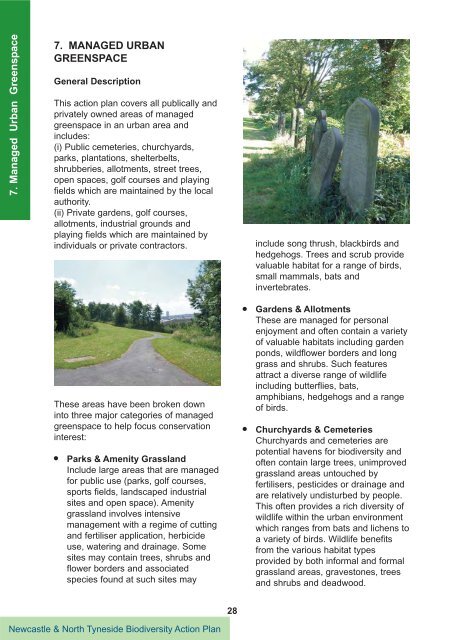III. Species Action Plans - Newcastle City Council
III. Species Action Plans - Newcastle City Council
III. Species Action Plans - Newcastle City Council
Create successful ePaper yourself
Turn your PDF publications into a flip-book with our unique Google optimized e-Paper software.
7. Managed Urban Greenspace<br />
7. MANAGED URBAN<br />
GREENSPACE<br />
General Description<br />
This action plan covers all publically and<br />
privately owned areas of managed<br />
greenspace in an urban area and<br />
includes:<br />
(i) Public cemeteries, churchyards,<br />
parks, plantations, shelterbelts,<br />
shrubberies, allotments, street trees,<br />
open spaces, golf courses and playing<br />
fields which are maintained by the local<br />
authority.<br />
(ii) Private gardens, golf courses,<br />
allotments, industrial grounds and<br />
playing fields which are maintained by<br />
individuals or private contractors.<br />
These areas have been broken down<br />
into three major categories of managed<br />
greenspace to help focus conservation<br />
interest:<br />
Parks & Amenity Grassland<br />
Include large areas that are managed<br />
for public use (parks, golf courses,<br />
sports fields, landscaped industrial<br />
sites and open space). Amenity<br />
grassland involves intensive<br />
management with a regime of cutting<br />
and fertiliser application, herbicide<br />
use, watering and drainage. Some<br />
sites may contain trees, shrubs and<br />
flower borders and associated<br />
species found at such sites may<br />
<strong>Newcastle</strong> & North Tyneside Biodiversity <strong>Action</strong> Plan<br />
28<br />
include song thrush, blackbirds and<br />
hedgehogs. Trees and scrub provide<br />
valuable habitat for a range of birds,<br />
small mammals, bats and<br />
invertebrates.<br />
Gardens & Allotments<br />
These are managed for personal<br />
enjoyment and often contain a variety<br />
of valuable habitats including garden<br />
ponds, wildflower borders and long<br />
grass and shrubs. Such features<br />
attract a diverse range of wildlife<br />
including butterflies, bats,<br />
amphibians, hedgehogs and a range<br />
of birds.<br />
Churchyards & Cemeteries<br />
Churchyards and cemeteries are<br />
potential havens for biodiversity and<br />
often contain large trees, unimproved<br />
grassland areas untouched by<br />
fertilisers, pesticides or drainage and<br />
are relatively undisturbed by people.<br />
This often provides a rich diversity of<br />
wildlife within the urban environment<br />
which ranges from bats and lichens to<br />
a variety of birds. Wildlife benefits<br />
from the various habitat types<br />
provided by both informal and formal<br />
grassland areas, gravestones, trees<br />
and shrubs and deadwood.

















